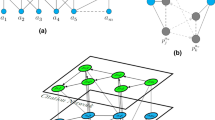Abstract
The increasing cooperation in science, which has led to larger co-authorship networks, requires the application of new methods of analysis of social networks in bibliographic co-authorship networks as well as in networks visible on the Web. In this context, a number of interesting papers on the “Erdős Number”, which gives the shortest path (geodesic distance) between an author and the well-known Hungarian mathematician Erdős in a co-authorship network, have been published recently. This paper develops new methods concerning the position of highly productive authors in the network. Thus a relationship of distribution of these authors among the clusters in the co-authorship network could be proved to be dependent upon the size of the clusters. Highly productive authors have, on average, low geodesic distances and thus shorter length of paths to all the other authors of a specialism compared to low productive authors, whereas the influencing possibility of highly productive scientists gets distributed amongst others in the development of the specialism. A theory on the stratification in science with respect to the over random similarity of scientists collaborating with one another, previously covered with other empirical methods, could also be confirmed by the application of geodesic distances. The paper proposes that the newly developed methodology may also be applied to visible networks in future studies on the Web. Further investigation is warranted into whether co-authorship and web networks have similar structures with regards to author productivity and geodesic distances.
Similar content being viewed by others
References
Bakker, P., Rigter, H. (1985), Editors of medical journals: Who and from where. Scientometrics, 7: 11-22.
Balaban, A. T., Klein, D. J. (2002), Co-authorship, rational Erdős numbers, and resistance distances in graphs, Scientometrics, 55: 59-70.
Batagelj, V., Ferligoj, A., Doreian, P. (1992), Direct and indirect methods for structural equivalence, Social Networks, 14: 63-90.
Bogaert, J., Rousseau, R., Van Hecke, P. (2000), Percolation as a model for informetric distributions: Fragment size distribution characterised by Bradford curves. Scientometrics, 47: 195-206.
Braun, T., GlÄnzel, W., Schubert, A. (2001), Publication and cooperation patterns of the authors of neuroscience journals. Scientometrics, 51: 499-510.
Czerwon, H.-J. (1993), Bibliometrische Verteilungen und die Evolution von Frontgebieten der Grundlagenforschung. In: W. Neubauer, K.-H. Meier (Eds), Deutscher Dokumentartag 1992, Frankfurt am Main: Deutsche Gesellschaft für Dokumentation e.V., pp. 625-640.
Genest, C., Thibault, C. (2001), Investigating the concentration within a research community using joint publications and co-authorship via intermediaries. Scientometrics, 51: 429-440.
GlÄnzel, W. (2002), Coauthorship patterns and trends in the sciences (1980–1998): A bibliometric study with implications for database indexing and search strategies. Library Trends, 50: 461-473.
Kretschmer, H. (1997), Patterns of behaviour in co-authorship networks of invisible colleges. Scientometrics, 40: 579-591.
Kretschmer, H., Aguillo, I. (2003, unpublished), Visibility of COLLNET members. collaboration on the Web. Presented at the 9th International Conference on Scientometrics and Informetrics, Beijing 2003.
Kretschmer, H., Thelwall, M. (2003), The Development of Information Professionals: The European Perspective — The Way from Librametry to Webometrics. MALA: Madras 2003, pp. 13-25.
Newman, M. (2001), The structure of scientific collaboration networks. Proceedings of the National Academy of Sciences of the USA, 98: 404-409.
Otte, E., Rousseau, R. (2002), Social network analysis: a powerful strategy, also for the information sciences. Journal of Information Science, 28: 443-455.
Wasserman, S., Faust, K. (1994), Social Network Analysis. Methods and Applications. Cambridge: Cambridge University Press 1994.
Wilkinson, D., Harries, G., Thelwall, M., Price, L. (2003), Motivation for academic web site interlinking: evidence for the web as a novel source of information on informal scholarly communication. Journal of Information Science, 29: 59-66.
Wolf, CH. (1996), Gleich und gleich gesellt sich. Individuelle und strukturelle Einflüsse auf die Entstehung von Freundschaften. Hamburg: Verlag Dr. Kovac.
Author information
Authors and Affiliations
Rights and permissions
About this article
Cite this article
Kretschmer, H. Author productivity and geodesic distance in bibliographic co-authorship networks, and visibility on the Web. Scientometrics 60, 409–420 (2004). https://doi.org/10.1023/B:SCIE.0000034383.86665.22
Issue Date:
DOI: https://doi.org/10.1023/B:SCIE.0000034383.86665.22




